Titanic’s Calvados Glazed Roast Duckling with Apple Sauce

Picture this: the most luxurious dining experience from the world’s most famous ship, recreated right in your own kitchen!
This isn’t just any roast duck recipe – it’s a piece of culinary history that brings the elegance of Edwardian fine dining straight to your table.
The combination of tender, perfectly roasted duckling with that incredible calvados glaze creates layers of flavor that’ll have your guests thinking you’ve hired a professional chef.
Every bite delivers that perfect balance of rich, succulent duck meat with the sweet-tart brightness of apple and the sophisticated warmth of French apple brandy.
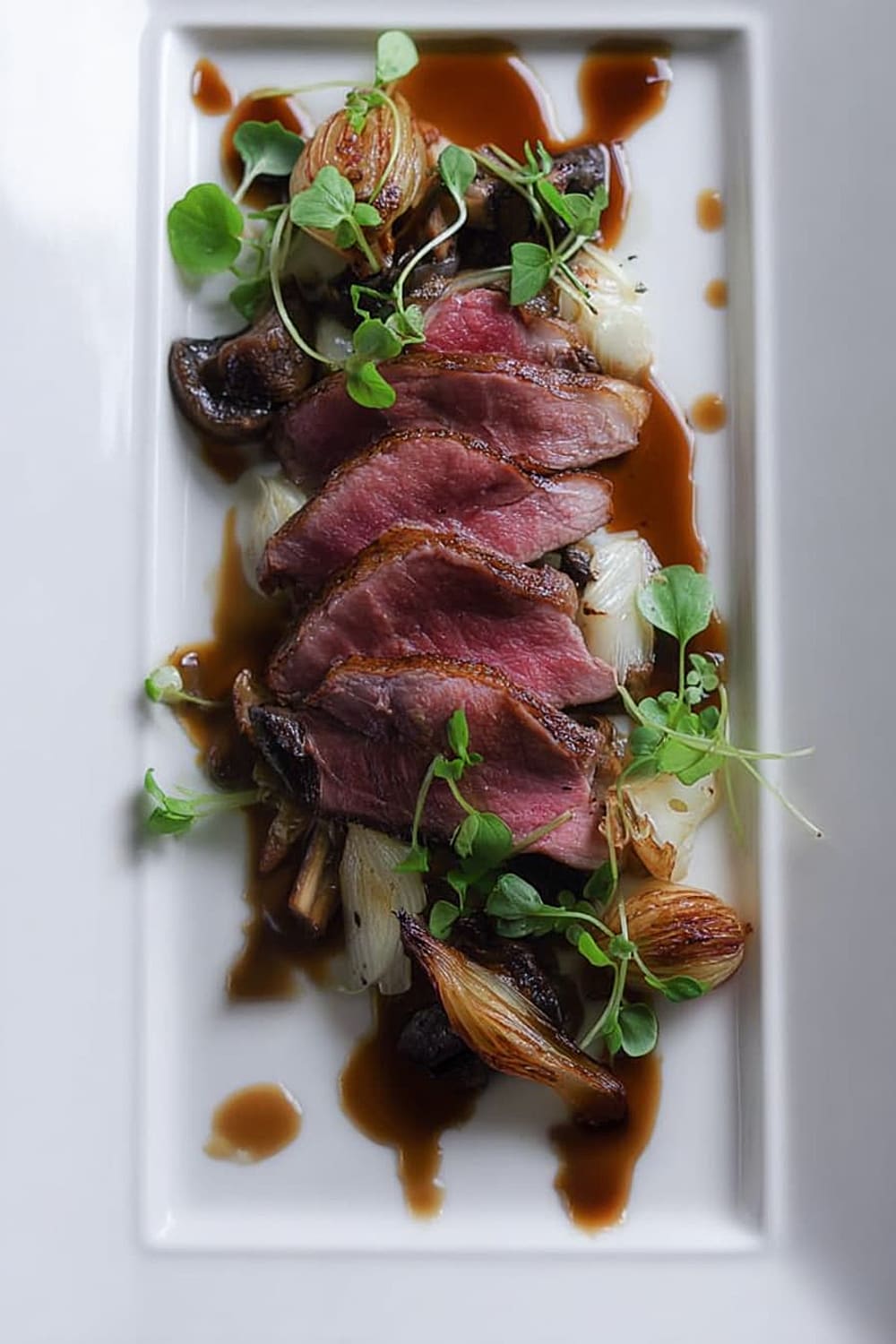
What makes this recipe absolutely magical is how the calvados transforms during cooking, creating this glossy, caramelized glaze that makes the duck skin incredibly crispy while keeping the meat unbelievably juicy.
The homemade apple sauce isn’t just a side dish – it’s the perfect flavor companion that cuts through the richness with its fresh, tangy sweetness.
And let’s talk about that aroma!
Your kitchen will smell like the finest French restaurant, with hints of roasted herbs, caramelized sugar, and that distinctive apple brandy fragrance that makes this dish truly special.

Ingredients
For the Duckling
- 1 duckling (about 4 pounds)
- 1 tablespoon chopped fresh thyme
- 1 /2 teaspoon salt
- 1 /2 teaspoon pepper
- 2 shallots, peeled and halved
- 1 small tart apple, cored and quartered
For the Calvados Glaze
- 1 /2 cup chicken broth
- 1 /2 cup calvados or apple cider
- 1 /2 cup brown sugar
For the Apple Sauce
- 1 tablespoon vegetable oil
- 2 small shallots, peeled, ends removed, finely chopped
- 1 teaspoon sugar
- 1 teaspoon cider vinegar
- 2 large tart apples, peeled, cored and chopped
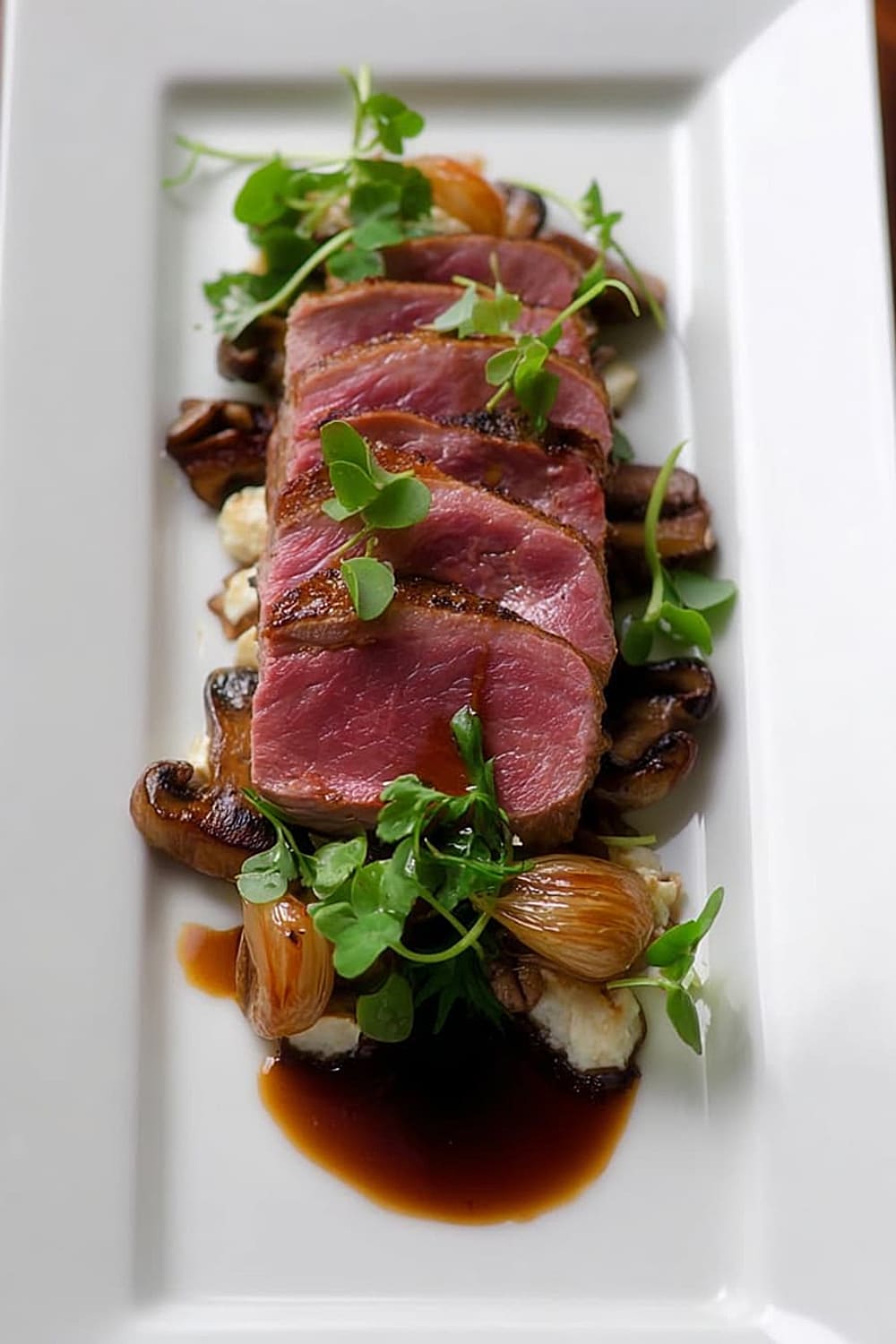
Instructions
Preparation
- 1 Remove giblets and neck from duck, rinse and pat dry inside and out using paper towels or a clean kitchen towel.
- 2 Trim excess fat from both ends of cavity. In small bowl, stir together chopped fresh thyme, salt, and pepper, then rub this herb mixture all over duck, inside and out. Place halved shallots and quartered apple inside cavity. Using poultry pins or basting needle, truss cavity closed. Twist wing tips behind back.
Initial Roasting
- 3 Place duck, breast side up on rack in large roasting pan. Roast in 425°F (220°C) oven for 20 minutes. Shield breast meat with aluminum foil, reduce heat to 350°F (175°C) and bake for 1 hour or until instant-read meat thermometer registers 180°F (82°C) when inserted into leg. Place on heated platter.
Creating the Glaze
- 4 Set roasting pan on stove over medium-high heat; skim off fat using a large spoon or fat separator. Stir in chicken stock and calvados. Bring to boil, stirring to scrape up any brown bits from the bottom of the pan. Boil for 5 minutes or until reduced to 1/2 cup. Stir in brown sugar and continue to cook for 3-5 minutes or until slightly syrupy. Pour into heatproof bowl.
Final Glazing
- 5 Return duck to roasting pan; remove foil and brush with half the glaze using a pastry brush or silicone brush. Bake in 350°F (175°C) oven for 5 minutes and brush with remaining glaze. Roast for 20 minutes longer. Increase heat to 475°F (246°C) and cook for 5 minutes or until skin is well browned and crisp. Remove to heated platter, tent with foil and let rest for 20 minutes.
Apple Sauce Preparation
- 6 While duck is resting, prepare the applesauce. In a heavy-bottomed saucepan, heat the vegetable oil over medium heat. Add the chopped shallots and sauté 5 minutes or until they are softened.
- 7 Sprinkle the sugar over the shallots and continue sautéing them, stirring often, for 5 minutes or until shallots are well browned and very soft.
- 8 Stir in the cider vinegar and chopped apples. Reduce heat slightly. Cover and cook 7-8 minutes or until apples are tender. Mash mixture until smooth using a potato masher or immersion blender and serve with duck.
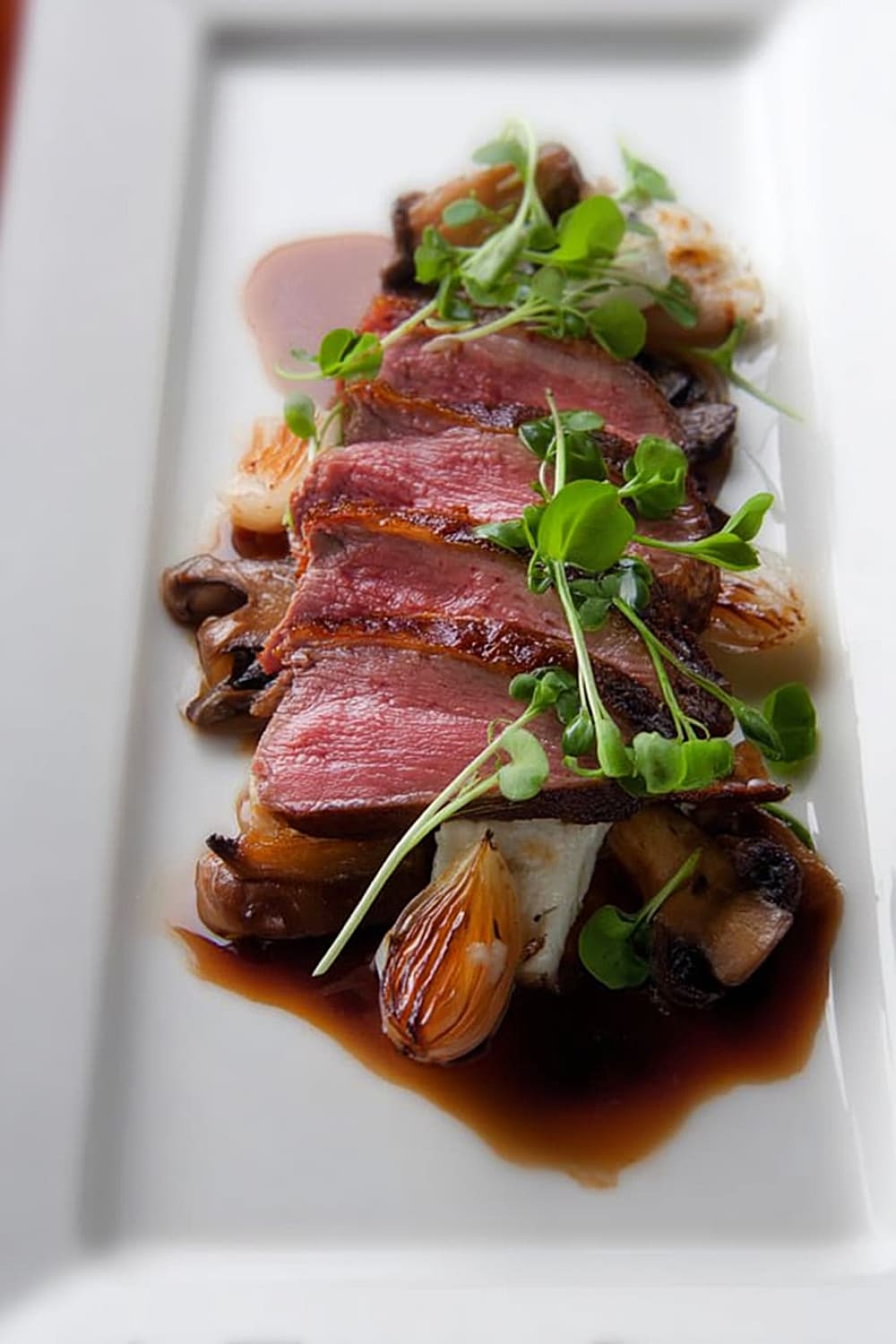
Recommended Equipment and Kitchen Tools
Essential Tools (for best results):
- Large roasting pan with rack – ensures even cooking and proper air circulation around the duck
- Instant-read meat thermometer – critical for achieving perfect doneness without overcooking
- Pastry brush or silicone brush – essential for applying the calvados glaze evenly
- Heavy-bottomed saucepan – prevents the apple sauce from burning and ensures even heat distribution
Helpful Upgrades:
- Digital kitchen scale – for precise measurements, especially important when scaling this recipe
- Fat separator – makes removing excess fat from pan drippings much easier than skimming with a spoon
- Cast iron skillet – can substitute for the saucepan when making apple sauce, provides excellent heat retention
- Microplane grater – perfect for zesting citrus if you want to add brightness to the apple sauce
Nice-to-Have Options:
- Poultry shears – makes trimming excess fat and carving much easier than using a knife
- Carving board with juice groove – keeps your workspace clean when slicing the finished duck
- Aluminum foil – essential for tenting and protecting the breast meat during roasting

Recipe Variations and Dietary Modifications
Alcohol-Free Adaptation:
- Replace calvados with apple cider or apple juice plus 1 tablespoon apple cider vinegar
- Add 1/2 teaspoon vanilla extract to enhance the apple flavor complexity
- Reduce cooking time for glaze by 1-2 minutes since alcohol won’t need to cook off
Herb Variations:
- Substitute thyme with fresh rosemary or sage for different flavor profiles
- Add orange zest to the herb rub for citrus brightness
- Include juniper berries in the cavity for a more traditional European approach
Glaze Alternatives:
- Maple syrup instead of brown sugar creates a deeper, more complex sweetness
- Honey and Dijon mustard combination for a sweet-tangy glaze
- Pomegranate molasses for a Middle Eastern twist with tart complexity
Apple Sauce Variations:
- Add cinnamon and nutmeg for warming spices
- Include dried cranberries for texture and tartness
- Substitute pears for half the apples for a more delicate flavor
- Add fresh ginger for a subtle spicy kick
Seasonal Modifications:
- Fall version: add butternut squash to the cavity alongside apples
- Winter variation: include chestnuts in the stuffing mixture
- Spring adaptation: use fresh fennel and lemon in the herb rub
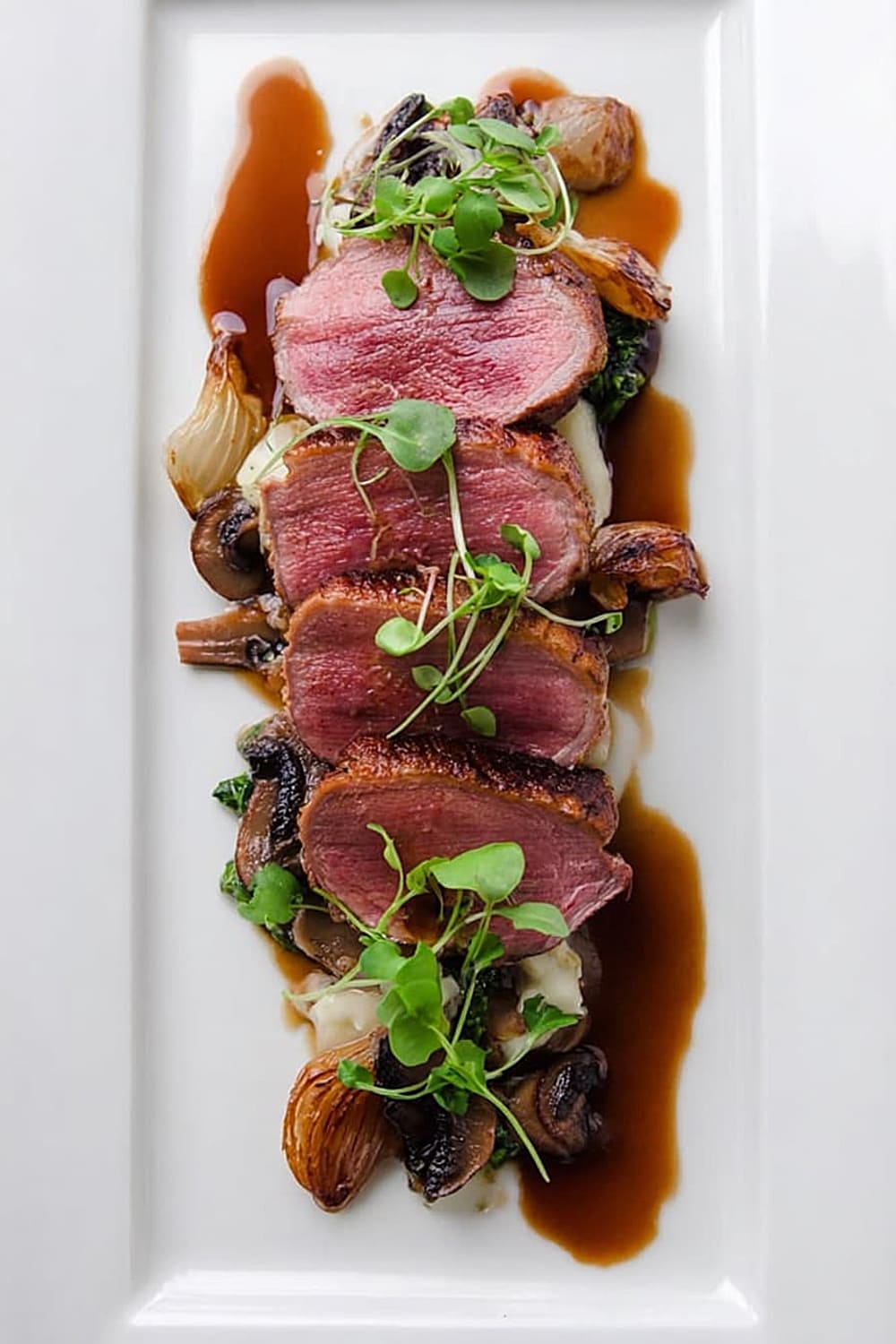
Nutritional Information and Health Benefits
Key Nutritional Highlights:
This elegant dish provides approximately 450-500 calories per serving, with duck being an excellent source of high-quality protein (about 35-40 grams per serving). Duck meat contains all essential amino acids and provides significant amounts of selenium, phosphorus, and B-vitamins, particularly B12 and niacin. The calvados glaze adds minimal calories while contributing antioxidants from the apple base, and the fresh apple sauce provides dietary fiber and vitamin C.
Health Benefits of Main Ingredients:
Duck meat is rich in iron and zinc, supporting immune function and energy metabolism. Unlike chicken, duck provides more monounsaturated fats, which can support heart health when consumed as part of a balanced diet. Fresh thyme contains thymol, a compound with antimicrobial properties, while shallots provide quercetin, a powerful antioxidant that may help reduce inflammation. Apples in both the stuffing and sauce contribute pectin, a soluble fiber that supports digestive health and may help regulate blood sugar levels.
Dietary Considerations:
This recipe is naturally gluten-free and dairy-free, making it suitable for those with common food sensitivities. It’s also keto-friendly when served without additional starches, as the net carbs are primarily from the apple components. The dish provides excellent protein density and healthy fats, though portion control is important due to the rich nature of duck meat and the added sugars in the glaze.

Smart Swaps and Ingredient Substitutions
Common Substitutions:
- Calvados → Apple brandy, cognac, or apple cider with 1 tablespoon apple cider vinegar
- Fresh thyme → Dried thyme (use 1 teaspoon) or fresh rosemary (same amount)
- Brown sugar → Maple syrup (reduce to 1/3 cup) or coconut sugar (same amount)
- Chicken broth → Vegetable broth or apple cider for different flavor profiles
Budget-Friendly Swaps:
- Whole duckling → Duck legs and thighs (more affordable, adjust cooking time to 45-60 minutes)
- Fresh shallots → Yellow onion (use 1/2 medium onion, finely chopped)
- Calvados → Apple juice plus 2 tablespoons brandy extract
Pantry Emergency Substitutions:
- Fresh apples → Unsweetened applesauce (reduce cooking time for sauce)
- Cider vinegar → White wine vinegar or lemon juice
- Vegetable oil → Butter or olive oil for the apple sauce
Pro Tips for Substitutions:
- When using apple cider instead of calvados, add it earlier in the cooking process to concentrate flavors
- Store leftover calvados in a cool, dark place – it keeps indefinitely and enhances many dessert recipes

Make It Diabetes-Friendly
Sugar Substitutions:
- Replace 1/2 cup brown sugar with 1/4 cup erythritol or stevia blend (reduces carbs by approximately 45 grams)
- Use sugar-free maple syrup for the glaze instead of brown sugar
- Add 1/2 teaspoon vanilla extract to enhance sweetness perception without added sugars
Carb Reduction Strategies:
- Apple Sauce modification: Use only 1 large apple instead of 2, add 1/2 cup cauliflower for bulk and fiber
- Glaze adjustment: Reduce to 2 tablespoons brown sugar substitute and add 1 tablespoon apple cider vinegar for complexity
- Portion control: Serve 4-ounce portions of duck with 2 tablespoons apple sauce
Blood Sugar Management Tips:
- Pair with non-starchy vegetables like roasted Brussels sprouts or green beans
- Include healthy fats like avocado salad to slow glucose absorption
- Serve with cauliflower mash instead of traditional potatoes
Total Carb Reduction: Modified version contains approximately 8-10 grams net carbs per serving versus 25-30 grams in original recipe

Perfect Pairing Suggestions
Beverage Pairings:
Red wine lovers should reach for a Pinot Noir or Côtes du Rhône – their earthy undertones complement the duck’s richness while the acidity cuts through the fat beautifully. For white wine enthusiasts, a Chardonnay or Viognier provides enough body to stand up to the duck while echoing the apple flavors. Beer pairs wonderfully too – try a Belgian dubbel or brown ale for maltiness that enhances the caramelized glaze. Non-alcoholic options include sparkling apple cider or pomegranate juice mixed with sparkling water.
Side Dish Recommendations:
Roasted root vegetables like parsnips, carrots, and turnips provide earthy sweetness that complements the apple elements. Wild rice pilaf with dried cranberries adds textural contrast and nutty flavors. Braised red cabbage with apples creates a traditional European accompaniment that won’t compete with the main dish. Honey-glazed Brussels sprouts offer a slightly bitter note that balances the rich duck perfectly.
Complete Meal Ideas:
Start with a mixed green salad with walnuts and dried cherries to prepare the palate. Follow with the duck as your centerpiece, accompanied by garlic mashed potatoes and steamed green beans with almonds. Finish with a light pear tart or apple sorbet to cleanse the palate. For entertaining, this menu serves 6-8 people beautifully and can be partially prepared ahead of time.

Pro Tips and Troubleshooting
Professional Techniques:
Score the duck skin in a crosshatch pattern before seasoning – this helps render fat more effectively and creates incredibly crispy skin. Prick the skin all over with a fork before roasting to release additional fat. Save the rendered duck fat – it’s liquid gold for roasting potatoes or vegetables and keeps refrigerated for months. Rest the duck for the full 20 minutes; this allows juices to redistribute and makes carving much easier.
Common Mistake Prevention:
Don’t skip the foil tenting during initial roasting – duck breast meat can dry out quickly at high temperatures. Watch the glaze carefully during the final browning stage; the sugars can burn rapidly at 475°F (246°C). Use a meat thermometer rather than relying on timing alone – duck size varies significantly. Skim fat thoroughly from pan drippings or your glaze will be greasy rather than glossy.
Storage and Make-Ahead Strategies:
Cooked duck keeps refrigerated for 3-4 days and reheats beautifully in a 300°F (150°C) oven. Apple sauce can be made 2 days ahead and actually improves in flavor. Freeze portions of cooked duck for up to 3 months – thaw overnight and reheat gently. Scale the recipe by using duck pieces instead of whole birds for larger crowds.
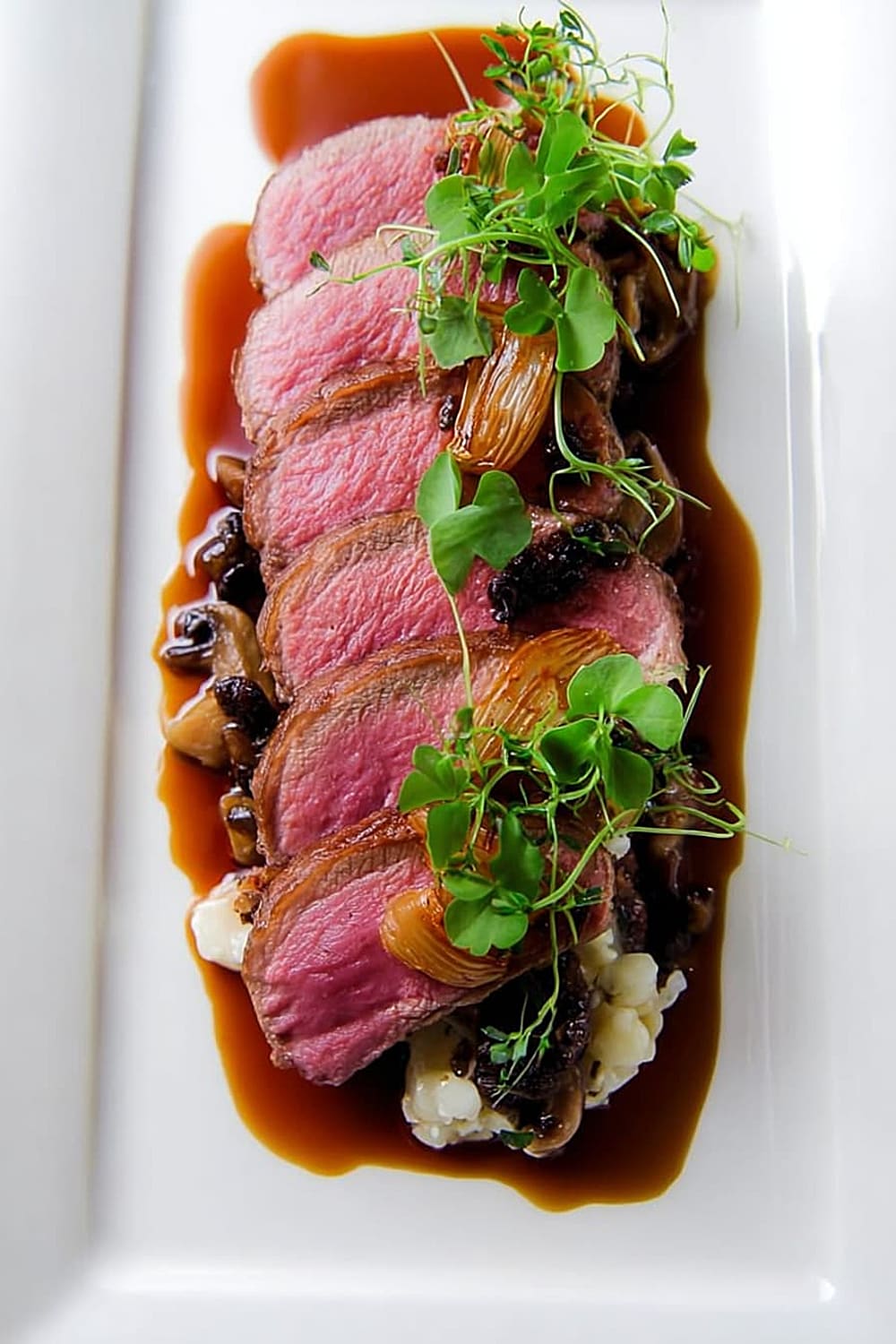
This Titanic-inspired masterpiece transforms any dinner into a special occasion, bringing together the elegance of Edwardian dining with flavors that feel both sophisticated and comfortingly familiar. Whether you’re celebrating a special anniversary, hosting a dinner party, or simply want to treat yourself to something extraordinary, this calvados-glazed duckling delivers an unforgettable culinary experience that’s surprisingly achievable in your home kitchen.